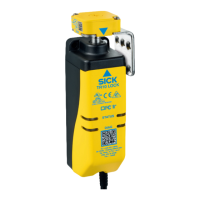4.4.3 Application diagnostic output
The application diagnostic output signal changes as soon as the actuator is moved into
or leaves the response range of the safety switch. In other words, it does so when the
moving protective device is opened and closed. This is not a safety output.
Table 1: Application diagnostic output switching behavior
Actuator Application diagnostic output
Actuator not in response area or safety locking
device in a faulty state
ON
Actuator in response area OFF
4.4.4 Cascading
Cascading can be used to connect multiple safety locking devices. The connected
devices will provide the combined safety outputs and therefore act outwardly like one
device.
2
8
4
7
3
5
6
1
OSSD1
OSSD2
OSSD1
OSSD2
OSSD1
OSSD2
OSSD1
OSSD2
OSSD1
OSSD2
2
8
4
7
3
5
6
1
2
8
4
7
3
5
6
1
2
8
4
7
3
5
6
1
2
8
4
7
3
5
6
1
24 V DC
0 V DC
1
// ///
1
1
1 1
2
1
TR10 Lock
2
Safe evaluation unit
The maximum number of safety locking devices depends on the following factors:
•
Supply voltage applied
•
Length of cables used
•
Cross-section of cables used
•
Load current
The voltage drop in the cascade must be checked to ensure that the defined minimum
voltage is still present at the last safety locking device.
The number of safety locking devices in a cascade influences the response time (see
"Response time", page 36).
The cascade can be implemented using special T-connectors and an end connector
(see "Connecting a cascade", page 25).
NOTE
In the case of safety switches cascaded using T-connectors, it is not possible to evalu‐
ate the application diagnostic output.
4.5 Testing plan
Overview
The manufacturer of the machine and the operating entity must define all required
thorough checks. The definition must be based on the application conditions and the
risk assessment and must be documented in a traceable manner.
4 PROJECT PLANNING
18
O P E R A T I N G I N S T R U C T I O N S | TR10 Lock 8019972/1CS1/2022-07-20 | SICK
Subject to change without notice

